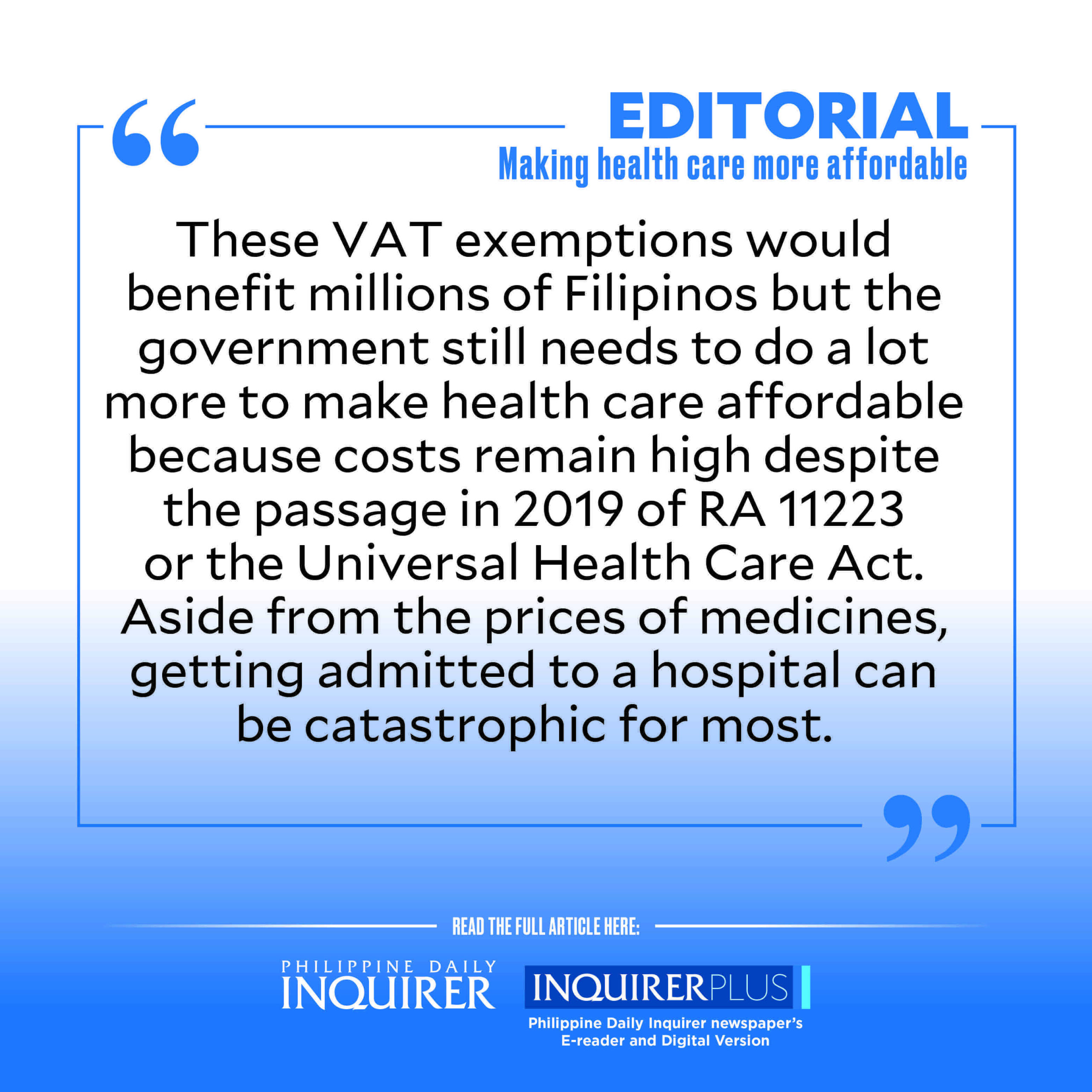Making health care more affordable
Many people, as the World Health Organization (WHO) said, are just one illness away from poverty. Despite advancements in treatments and a multitude of health trends around the world that help people live longer and healthier lives, there are still those who cannot afford health care and who die without even seeing a health professional. This is a common case in a country like the Philippines where there is a lack of public-run facilities and the cost of medicines remains one of the most expensive in the world.Oftentimes, getting sick, especially with chronic illness, is a choice between saving a life or falling into deep debt. This is why the Department of Health’s (DOH) recent announcement that 21 medicines have been exempted from value-added tax (VAT) brings huge relief to patients and their families who are burdened with the prohibitive cost of treatment. The medicines specified under Revenue Memorandum Circular No. 17-2024 are for the treatment of cancer, diabetes, hypertension, kidney disease, mental illness, and tuberculosis.
Maintenance medicines
Data from the WHO show that the top causes of death in the Philippines are ischaemic heart disease, also called coronary heart disease or coronary artery disease; lower respiratory infections; stroke; kidney diseases; diabetes; hypertensive heart disease; chronic obstructive pulmonary disease; and tuberculosis. Health Secretary Teodoro Herbosa said limited access to medicines that help control these diseases contributes to the rise in cancer, tuberculosis, diabetes, and hypertension deaths. The poor stop taking medicines because of the prohibitive cost, he added.
Article continues after this advertisementLast year, the government exempted 59 medicines from VAT including maintenance drugs for diabetes, high cholesterol, hypertension, and mental illness. These exemptions have been provided under Republic Act No. 11534, or the Corporate Recovery and Tax Incentives for Enterprises Act signed in 2021.
To be sure, these exemptions would benefit millions of Filipinos but the government still needs to do a lot more to make health care affordable because costs remain high despite the passage in 2019 of RA 11223 or the Universal Health Care Act. Aside from the prices of medicines, getting admitted to a hospital can be catastrophic for most.
More private hospitals
Vincen Gregory Yu, a research associate at the Ateneo de Manila University’s development studies program, called the regular Filipino’s health-care journey the 4Ps: “Pagtitiis,” which entails enduring the symptoms and instead of seeking professional help, resorting to alternative medicine or self-medication; “Pangungutang,” or borrowing money that could lead the desperate outside of their network of family, friends, and co-workers to seek loans from money lenders, pawnshops, and other schemes that charge high-interest rates; “Pagmamakaawa,” or soliciting help from politicians, government agencies, and nongovernment organizations; and the Philippine Health Insurance Corp. (PhilHealth,) the corruption-riddled national health insurance system whose coverage needs a review. Yu noted, based on a study he conducted, that most people do not believe in PhilHealth or health insurance because there is little understanding of how they work.
Article continues after this advertisementThe government needs to pour more resources into building more hospitals and equipping barangay health centers with better facilities and resources to provide health care services to marginalized sectors who are discouraged from seeking professional help because of the cost. It speaks volumes of the government’s priority when the country has more private hospitals than public ones. Based on DOH data, there are about 1,071 private facilities compared to only 721 public hospitals.
Out-of-pocket expenditures
Specialty centers are also centralized in Metro Manila making it more difficult for patients who have no means to travel and to seek treatment at these facilities. Last year, President Marcos signed RA 11959 mandating the DOH to create regional specialty centers, a move that will make health care accessible to more Filipinos.
Herbosa said the new exemptions would help the DOH free up more budget for other equally important expenditures—this should include the construction of more provincial hospitals and specialty centers, as well as the improvement of health facilities that have suffered neglect due to inadequate budget. The government also needs to look into PhilHealth’s benefit package to include outpatient medicines. A 2016 study showed that out-of-pocket expenditures account for more than 50 percent of Filipinos’ total health expenditures, with the purchase of medicines taking a big chunk of it.
The ultimate goal should be a fully public health-care system—but this can only be possible if our policymakers increase spending for the health sector and ensure that these resources do not end up in the pockets of a few or are lost in the confusing maze of bureaucracy and lip service. Until these issues are addressed, getting sick will truly be a financial catastrophe for Filipinos.

















